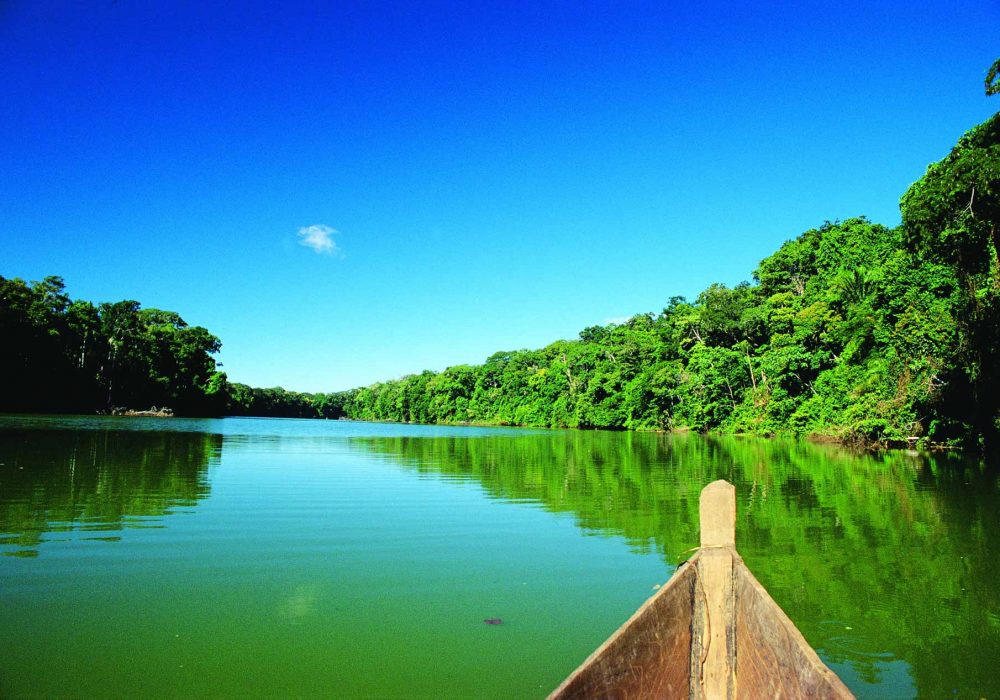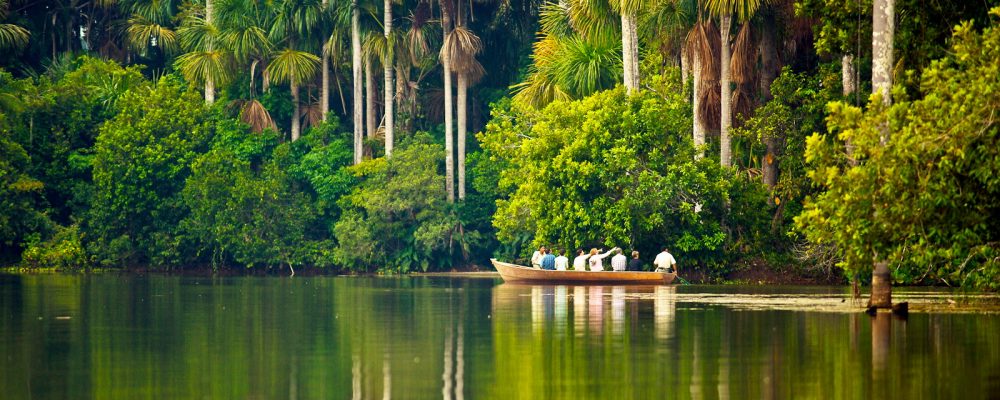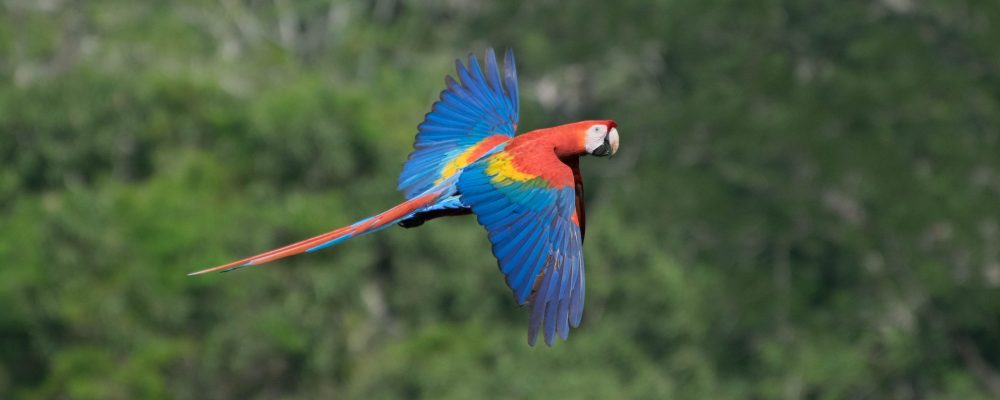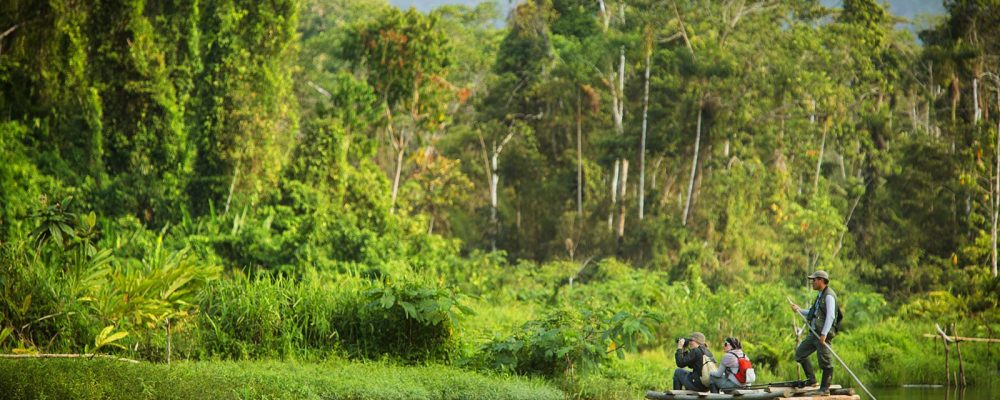Amazon Rainforest
The Amazon Rainforest, often referred to as the “Lungs of the Earth,” is the largest tropical rainforest in the world, spanning over nine countries in South America. Encompassing an area of approximately 6.7 million square kilometers, this vast and diverse ecosystem is home to an extraordinary array of plant and animal species, many of which are not found anywhere else on the planet. The Amazon plays a crucial role in regulating the Earth’s climate by absorbing and storing massive amounts of carbon dioxide while producing oxygen. It is also a source of invaluable biodiversity, providing habitat for millions of species, some of which are yet to be discovered. However, the Amazon Rainforest faces severe threats from deforestation, logging, and agricultural expansion, putting the delicate balance of this ecological treasure at risk and raising concerns about the long-term health of the planet. Conservation efforts and sustainable practices are crucial to preserving the Amazon Rainforest and ensuring the well-being of both its unique inhabitants and the global environment.

Overview
The Amazon Rainforest, often referred to as the “Lungs of the Earth,” is the largest tropical rainforest in the world, spanning approximately 6.7 million square kilometers (2.7 million square miles) across nine South American countries: Brazil, Peru, Colombia, Venezuela, Ecuador, Bolivia, Guyana, Suriname, and French Guiana. This vast and ecologically diverse region is home to an incredible array of plant and animal species, many of which are not found anywhere else on Earth.
Key features of the Amazon Rainforest include:

Biodiversity: The Amazon is renowned for its unparalleled biodiversity, harboring around 390 billion individual trees representing 16,000 different species. It is estimated that nearly 390 billion individual trees of around 16,000 different species can be found in the Amazon.
Flora and Fauna: The rainforest is home to a staggering variety of wildlife, including jaguars, pumas, tapirs, caimans, and an astonishing diversity of bird species. Additionally, countless insects, amphibians, and fish inhabit the region.
River System: The Amazon River, the second-longest river in the world, flows through the heart of the rainforest. Its intricate network of tributaries forms a vast and complex river system that is essential for the region’s ecology.
Indigenous Peoples: Numerous indigenous communities have inhabited the Amazon for thousands of years, relying on its resources for their livelihoods and cultural practices. These communities contribute to the rich cultural tapestry of the region.
Climate and Rainfall: The Amazon has a tropical climate with high temperatures and consistent rainfall throughout the year. The rainforest plays a crucial role in regulating the Earth’s climate by absorbing and storing vast amounts of carbon dioxide.
Deforestation and Environmental Threats: Despite its ecological importance, the Amazon Rainforest faces significant threats, primarily from deforestation. Agricultural activities, logging, and infrastructure development pose severe challenges to the region’s integrity, leading to habitat loss and fragmentation.
Conservation Efforts: Numerous organizations, governments, and environmental activists are working to address the threats facing the Amazon. Conservation initiatives aim to promote sustainable practices, protect indigenous rights, and raise awareness about the importance of preserving this vital ecosystem.
The Amazon Rainforest’s significance extends beyond its borders, as it plays a crucial role in global climate regulation, housing a substantial portion of the world’s biodiversity, and providing resources essential for local communities. Ensuring the long-term health and conservation of the Amazon Rainforest is a global concern that requires concerted efforts from the international community.
Manu National Park
Manu National Park is a UNESCO World Heritage-listed biosphere reserve and national park located in the Peruvian Amazon Basin. Encompassing an expansive area of over 15,000 square kilometers (5,800 square miles), Manu National Park is renowned for its incredible biodiversity and pristine, untouched rainforest ecosystems. It is considered one of the most biodiverse places on Earth, providing a haven for numerous plant and animal species.
Established in 1973, Manu National Park spans across the regions of Madre de Dios and Cusco in southeastern Peru. The park extends from the high Andes down to the lowland Amazon rainforest, encompassing a range of elevations and ecological zones. This diversity in altitude contributes to the park’s remarkable array of habitats, from cloud forests in the higher reaches to lowland tropical rainforests.
The park is home to an extraordinary variety of wildlife, including iconic species such as jaguars, pumas, tapirs, giant otters, and various species of monkeys. Additionally, Manu National Park boasts an impressive bird population, with over 1,000 species recorded, making it a paradise for birdwatchers. Notable bird species include harpy eagles, Andean condors, and countless colorful parrots and macaws.
One of the park’s distinctive features is the presence of indigenous people, primarily the Matsiguenka and Yora tribes, who have lived in harmony with the rainforest for centuries. Manu National Park serves as their ancestral home, and their traditional practices are essential components of the park’s cultural and ecological landscape.
The park’s remote and pristine nature has contributed to its relatively low level of human impact compared to other areas in the Amazon. This isolation has helped to preserve the rich biodiversity and ecological integrity of Manu National Park. However, it also poses challenges in terms of conservation, as illegal logging, poaching, and other threats continue to pose risks to the delicate balance of the ecosystem.
Ecotourism has become an increasingly important aspect of Manu National Park, providing a sustainable means of raising awareness and generating funds for conservation efforts. Visitors to the park can experience the wonders of the Amazon rainforest, guided by knowledgeable naturalists who help minimize the environmental impact of tourism.
In conclusion, Manu National Park stands as a testament to the incredible biodiversity found within the Amazon rainforest. Its unique combination of ecosystems, diverse wildlife, and the presence of indigenous communities make it a crucial area for conservation and sustainable ecotourism. As a UNESCO World Heritage site, it highlights the importance of protecting and preserving these pristine environments for the benefit of future generations and the global ecosystem.

Tour Packages
Travel Tips

Traveling to the Amazon Rainforest can be a thrilling and rewarding experience, but it’s essential to be well-prepared for the unique challenges and opportunities that this environment presents. Here are some travel tips to help you make the most of your visit to the Amazon Rainforest:
Research and Plan Ahead:
Gain a good understanding of the region’s geography, climate, and wildlife before you go.
Plan your itinerary in advance, considering the specific areas of the Amazon you want to explore.
Choose the Right Time to Visit:
The Amazon has a wet season and a dry season. The wet season (December to June) brings heavy rain and flooded rivers, while the dry season (July to November) offers easier access to certain areas.
Vaccinations and Health Precautions:
Consult with a healthcare professional about necessary vaccinations, including yellow fever, malaria, and other tropical diseases.
Bring insect repellent, sunscreen, and any required medications.
Pack Appropriate Clothing and Gear:
Wear lightweight, long-sleeved clothing to protect against insects and the sun.
Bring a good pair of waterproof hiking boots and a rain jacket.
A hat, sunglasses, and a water bottle are also essential.
Guided Tours and Local Guides:
Consider joining a guided tour led by experienced local guides who are knowledgeable about the flora and fauna.
Local guides can enhance your experience by providing insights into the ecosystem and ensuring your safety.
Respect Local Culture and Environment:
Be mindful of the local communities and their customs. Respect their way of life and traditions.
Follow Leave No Trace principles to minimize your impact on the environment. Avoid littering and minimize noise.
Stay Hydrated:
The Amazon can be hot and humid, so it’s crucial to stay hydrated. Carry a reusable water bottle and drink plenty of fluids.
Be Wildlife Aware:
Observe wildlife from a safe distance and avoid disturbing or feeding animals.
Use binoculars and a camera with a good zoom lens to capture wildlife without getting too close.
Learn Basic Survival Skills:
Familiarize yourself with basic survival skills, such as navigation, identifying edible plants, and understanding basic first aid.
Travel Insurance:
Purchase comprehensive travel insurance that covers medical emergencies, trip cancellations, and any unforeseen circumstances.
Pack a First Aid Kit:
Include essentials like bandages, antiseptic cream, pain relievers, and any prescription medications you may need.
Transportation:
Be prepared for various modes of transportation, including boats and small planes, depending on your itinerary.
By being well-prepared and respectful of the environment and local communities, you can have a safe and unforgettable adventure in the Amazon Rainforest.
FAQ´s
The Amazon Rainforest is a unique and biodiverse ecosystem, home to a staggering variety of flora and fauna. Visiting allows you to witness the beauty of nature, experience indigenous cultures, and gain a deeper understanding of the importance of rainforests in maintaining global ecological balance.
The Amazon has a tropical climate, so it’s generally warm and humid throughout the year. The dry season, from June to November, is considered the best time to visit as there is less rainfall, making it easier to explore the rainforest and spot wildlife. However, the wet season (December to May) has its own unique charm and lush greenery.
Popular activities include guided jungle hikes, wildlife watching, bird watching, river cruises, and cultural experiences with local indigenous communities. Additionally, you can explore canopy walkways, visit wildlife rescue centers, and engage in sustainable ecotourism practices.
It is advisable to consult a travel health professional for vaccinations and health recommendations before visiting the Amazon. The region is known for diseases like malaria and yellow fever, so taking preventive measures, such as getting vaccinated and using mosquito repellent, is crucial.
Essential items include lightweight, long-sleeved clothing, a wide-brimmed hat, sturdy walking shoes, insect repellent, a rain jacket, and a good camera. It’s crucial to pack responsibly and minimize waste, as preserving the delicate ecosystem is paramount.
While it is possible to explore some areas independently, many parts of the Amazon are best experienced with a knowledgeable guide due to the complex and ever-changing nature of the rainforest. Guided tours enhance safety, provide valuable insights, and ensure a more meaningful experience.
Travelers should strive to minimize their environmental impact by following Leave No Trace principles. Choose eco-friendly accommodations, support local initiatives, and be mindful of waste. Responsible tourism is key to preserving the Amazon for future generations.
The highest point on the Inca Traa
Some areas of the Amazon may have restricted access to protect sensitive ecosystems and indigenous communities. Check with local authorities and tour operators for up-to-date information on any restrictions or permits required.
il is Dead Woman’s Pass (Warmiwañusca) at an altitude of approximately 13,828 feet (4,215 meters). Trekkers should acclimate to the altitude in Cusco before starting the trek to minimize the risk of altitude sickness.
Consider supporting local conservation organizations, practicing responsible tourism, and spreading awareness about the importance of preserving the rainforest. Make eco-conscious choices, such as reducing single-use plastic and supporting sustainable products, to contribute to the long-term health of this vital ecosystem.




